
Exploring the Mechanism of Er-zhi wan for the Treatment of IgA Nephropathy Based on Network Pharmacology
*Corresponding Author(s):
Xue-Xia LiDepartment Of Nephropathy, Zhuhai Hospital Of Integrated Chinese And Western Medicine, Zhuhai, Guangdong, China
Tel:+86 15018342882,
Email:sitalisa@163.com
Abstract
Objective: To explore the mechanism of Er-zhi wan for the treatment of IgAN based on network pharmacology.
Methods: The effective components and protein targets of Er zhi wan were extracted by TCMSP and regulated as gene targets by Uniprot database. Then, the network of Er zhi wan, effective components and gene targets was constructed by Cytoscape 3.7.1. Disease targets of IgAN were collected using Genecards and DisGeNET, and after the intersection gene targets of drugs and diseases were obtained, PPI analysis was performed using STRING11.5 database, and the PPI network map was constructed to clarify the core gene targets. Subsequently, GO function analysis and KEGG pathway enrichment analysis were performed using Metascape platform.
Results: A total of 21 effective components were screened out for Er zhi wan, and 193 gene targets were obtained. The number of gene targets for IgAN disease was 1743, and there were 117 overlapping gene targets between them. The core effective components such as quercetin, luteolin, kaempferol, β-sitosterol and robinin were obtained. The potential core gene targets were mainly AKT1, IL6, TNF, CASP3, VEGFA, etc. Potential targets are mainly concentrated in biological processes such as response to oxidative stress, response to hypoxia, response to reactive oxygen species, and signaling pathways such as cancer, lipid and atherosclerosis, fluid shear stress and arteriosclerosis, bladder cancer, IL-17 and TNF.
Conclusion: Er-zhi wan acts on gene targets such as AKT1, IL6 and TNF mainly through effective components such as quercetin and luteolin, and plays a role in treating IgAN through signal pathways such as IL-17 and TNF. It has the characteristics of synergistic effect of multi-components, multi-pathways, multi-targets and multi-pathways.
Keywords
Er zhi wan; Network pharmacology; IgA Nephropathy
IgA Nephropathy (IgAN) refers to a type of disease in which immune complexes, mainly immunoglobulin A, deposit in the glomerular mesangium, leading to hematuria, with or without proteinuria. It is the most common primary glomerular disease worldwide [1]. Its pathological mechanism is not clear and there is no specific treatment for it. Therefore, exploring its pathogenesis and searching for its effective treatment are important. There is no specific disease name for IgAN in Traditional Chinese Medicine (TCM). It is often classified as a disease category such as bloody gonorrhea, edema, urine turbidity, etc. The overall pathogenesis of IgAN is based on deficiency and excess, with deficiency mainly characterized by Qi deficiency and Yin deficiency. The symptoms are mainly external sensations, damp heat, and blood stasis. Syndrome differentiation types are mainly liver and kidney deficiency, Yin deficiency and excessive fire. In terms of treatment, the classic formula Erzhi Pill and Zhibai Dihuang Pill are often used to nourish Yin and reduce fire.
Erzhi Pill originates from the "Fu Shou Jing Fang", composing of Ligustrum lucidum and Eclipta grandiflora. It has the effects of nourishing the liver and kidney, nourishing Yin and blood. Erzhi Pill is one of the most commonly used clinical combinations for kidney diseases. Clinical studies suggest that Erzhi Pill has good therapeutic effects on IgAN of liver and kidney Yin deficiency type and Qi Yin deficiency type. It can improve patients' symptoms, clinical indicators, and immune function. Due to the characteristics of multiple components, multiple targets, multiple pathways, mutual coordination, and systematic regulation of TCM, using traditional methods to study TCM is difficult to reflect systematicity. It is difficult to scientifically explain the pharmacological material basis of TCM formulas. Thus, the mechanism of Erzhi Pill's action on kidney disease is still unclear, which limits its widespread clinical application. Therefore, this article explores the main effective ingredients, target genes, and pathways of Erzhi Pill in the treatment of IgAN through data mining, further clarifying the mechanism of action of Erzhi Pill in the treatment of IgAN for the promotion and application of TCM.
Methods
- Mining of effective components and gene targets in erzhi pills
In the pharmacology database and analysis platform of traditional Chinese medicine system [1] (TCMSP, http://lsp.nwu.edu.cn/tcmsp.php) Input two traditional Chinese medicines from the Erzhi Pill formula: Ligustrum lucidum and Eclipta grandiflorum. Use oral bioavailability (OB) ≥ 30 and drug like index (DL) ≥ 0.18 as screening criteria to screen their effective ingredients. Subsequently, protein targets of active ingredients were obtained through the TCMSP platform and inputted into the Uniprot database [3] ( https://www.uniprot.org/) Standardize as gene targets, merge the obtained gene targets and remove duplicate values to obtain the final gene target.
- Construction of erzhi pill TCM effective components gene target network diagram
Organize its active ingredients and gene targets, then import them into Cytoscape 3.7.1 software to construct a network diagram of TCM, active ingredients, and gene targets for Erzhi Wan, visualizing its pharmacological mechanism and clarifying its core effective ingredients.
- Mining of IgAN disease gene targets
Applying the GeneCards database [4] (https://www. Genecards. org), DisGeNET database (https://www.disgenet.org/) Obtain disease gene targets for IgAN, and use "IgA Nephropathy", "IgA Nephritis", and "IgAN" as search keywords. Merge the disease gene targets obtained from two disease databases and delete duplicate values to obtain the final disease gene targets.
- Mining of Intersection Gene Targets between Erzhi Pill and IgAN to Construct the Target Protein Interaction Network (PPI)
Import Erzhiwan and IgAN gene targets into the online platform of Weishengxin (http://www.bioinformatics.com.cn) Draw a Venn diagram to visualize intersecting gene targets. Simultaneously extract the intersection gene targets of Erzhiwan and IgAN through Excel. Subsequently submit it to the STRING11.5 database (https://string-db.org) Build a PPI network model with data settings: set the biological species to "Homo sapiens", set the minimum interaction threshold to "highest confidence (>0.9)", and hide its free gene targets. All other settings are set as default to obtain the PPI network. Afterwards, in order to clarify the core targets of the interaction between intersection gene targets, the PPI network diagram was imported into Cytoscape 3.7.1 software for visualization. At the same time, network topology attribute analysis was conducted using Tools tools to obtain the top 5 core genes in "node connectivity (degree)".
- GO Functional Enrichment Analysis and KEGG Pathway Enrichment Analysis
Importing intersection gene targets into the Metascape database [5] (http://metascape.org/gp/index.html) Conduct gene target enrichment analysis, including gene ontology (GO) functional enrichment analysis of intersecting gene targets and pathway enrichment analysis based on the Kyoto Encyclopedia of Genes and Genomes (KEGG). The top 20 results are selected based on the P-value size as the screening criteria, and visualized through the microbiological information online platform.
Results
- Effective ingredients and gene targets of Erzhi pill
Through the TCMSP database, a total of 167 active ingredients were found in Erzhi Pill. Using OB ≥ 30% and DL ≥ 0.18 as screening conditions, 21 active ingredients were ultimately obtained, including 2 common active ingredients in Ligustrum lucidum and Eclipta grandiflora, namely luteolin and quercetin, as shown in table 1. Exclusion (20S) -24-ene-3 β, 20-diol-3-acetate, butanolin diglucoside. There were no corresponding protein targets for the four active ingredients, namely syringarenol diglucoside_qt, Lucidresculine D, and Olitoriside. A total of 434 protein targets were obtained, and they were input into the Uniprot database for standardization. After removing duplicate values, 193 gene targets for the active ingredients of Erzhi Pill were ultimately obtained.
|
MOL ID |
Label |
Herbal Medicine |
Active Ingredient |
OB/% |
DL |
|
MOL000006 |
GY1 |
Ligustrum lucidum, Eclipta grandiflora |
luteolin |
36.16 |
0.25 |
|
MOL000098 |
GY2 |
Ligustrum lucidum, Eclipta grandiflora |
quercetin |
46.43 |
0.28 |
|
MOL000358 |
NZZ1 |
Ligustrum lucidum |
beta-sitosterol |
36.91 |
0.75 |
|
MOL000422 |
NZZ2 |
Ligustrum lucidum |
kaempferol |
41.88 |
0.24 |
|
MOL004576 |
NZZ3 |
Ligustrum lucidum |
taxifolin |
57.84 |
0.27 |
|
MOL005146 |
NZZ4 |
Ligustrum lucidum |
lucidumoside D |
48.87 |
0.71 |
|
MOL005147 |
NZZ5 |
Ligustrum lucidum |
lucidumoside D_qt |
54.41 |
0.47 |
|
MOL005169 |
NZZ6 |
Ligustrum lucidum |
(20S) -24-ene-3β, 20-diol-3-acetate |
40.23 |
0.82 |
|
MOL005190 |
NZZ7 |
Ligustrum lucidum |
eriodictyol |
71.79 |
0.24 |
|
MOL005195 |
NZZ8 |
Ligustrum lucidum |
syringaresinol diglucoside_qt |
83.12 |
0.8 |
|
MOL005209 |
NZZ9 |
Ligustrum lucidum |
lucidusculine |
30.11 |
0.75 |
|
MOL005211 |
NZZ10 |
Ligustrum lucidum |
Olitoriside |
65.45 |
0.23 |
|
MOL005212 |
NZZ11 |
Ligustrum lucidum |
olitoriside_qt |
103.2 |
0.78 |
|
MOL001790 |
MHL1 |
Eclipta grandiflora |
linarin |
39.84 |
0.71 |
|
MOL001689 |
MHL2 |
Eclipta grandiflora |
acacetin |
34.97 |
0.24 |
|
MOL002975 |
MHL3 |
Eclipta grandiflora |
butin |
69.94 |
0.21 |
|
MOL003378 |
MHL4 |
Eclipta grandiflora |
1,3,8,9-tetrahydroxybenzofurano[3,2-c]chromen-6-one |
33.94 |
0.43 |
|
MOL003389 |
MHL5 |
Eclipta grandiflora |
3'-O-Methylorobol |
57.41 |
0.27 |
|
MOL003398 |
MHL6 |
Eclipta grandiflora |
pratensein |
39.06 |
0.28 |
|
MOL003402 |
MHL7 |
Eclipta grandiflora |
demethylwedelolactone |
72.13 |
0.43 |
|
MOL003404 |
MHL8 |
Eclipta grandiflora |
wedelolactone |
49.6 |
0.48 |
Table 1: Active ingredients of Erzhi Pill.
- Erzhi pill active components gene target network diagram
Build an Excel table of the active ingredients collected in the TCMSP database and their standardized gene targets, and import them into Cytoscape 3.7.1 to construct a network diagram of traditional Chinese medicine active ingredients gene targets, as shown in figure 1. By analyzing the network graph, it can be seen that the top five compounds closely related to gene targets are quercetin, luteolin, kaempferol β- The specific data of sitosterol and Robinia pseudoacacia are shown in table 2.
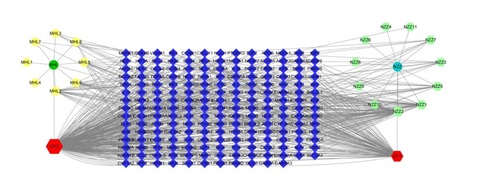 Figure 1: Active Ingredients and Gene Target Network Diagram of Erzhi Pill.
Figure 1: Active Ingredients and Gene Target Network Diagram of Erzhi Pill.
|
label |
Active ingredient |
connectivity |
intermedium |
tightness |
|
GY2 |
quercetin |
286 |
0.69731373 |
0.63049853 |
|
GY1 |
luteolin |
110 |
0.16583519 |
0.41910331 |
|
NZZ2 |
kaempferol |
57 |
0.1401472 |
0.41586074 |
|
NZZ1 |
beta-sitosterol |
33 |
0.12759178 |
0.38053097 |
|
MHL2 |
acacetin |
23 |
0.04957944 |
0.36256324 |
Table 2: Active ingredients most closely related to the targets.
- IgAN disease gene targets
The Genecards and DisGeNET databases were used to obtain IgAN disease related gene targets. The results showed that the Genecards database obtained 1603 disease gene targets, while the DisGeNET database obtained 456 disease gene targets. 316 duplicate gene targets were merged and removed, resulting in 1743 disease gene targets.
- Mining and PPI network construction of intersection gene targets between erzhiwan and IgAN
The gene targets (193) and IgAN disease gene targets (1743) obtained through screening were inputted into the WeChat online mapping platform to obtain the Venn map (Figure 2). At the same time, intersection gene targets were screened through Excel, resulting in a total of 117 gene targets for the treatment of IgAN with Erzhi Pill. Import the obtained intersection gene targets into the STRING11.5 database for PPI analysis between targets and visualize them to obtain a PPI network diagram, as shown in figure 3. The larger the circle and darker the color in the diagram, the greater the influence of the target. Using node connectivity (degree) as the screening criteria, select the top 5 targets with the highest degree to identify their core gene targets, namely AKT1, IL6, TNF, CASP3, and VEGFA. Please refer to table 3 for details.
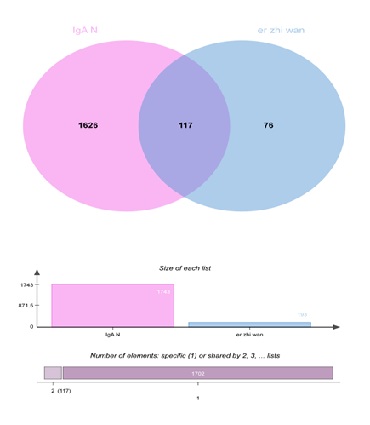 Figure 2: Venn map of the intersection gene targets between Erzhiwan and IgAN.
Figure 2: Venn map of the intersection gene targets between Erzhiwan and IgAN.
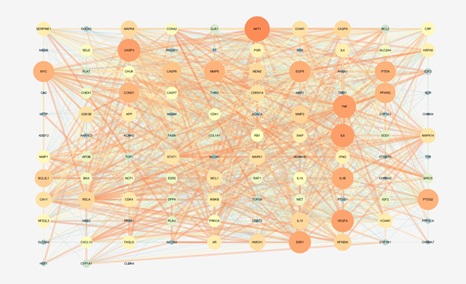 Figure 3: PPI diagram of intersection gene targets.
Figure 3: PPI diagram of intersection gene targets.
|
Gene Targets |
Degree |
Betweenness Centrality |
Closeness Centrality |
|
AKT1 |
83 |
0.11337182 |
0.78873239 |
|
IL6 |
75 |
0.04658224 |
0.74172185 |
|
TNF |
74 |
0.03691461 |
0.72727273 |
|
CASP3 |
73 |
0.03632742 |
0.72727273 |
|
VEGFA |
72 |
0.02328299 |
0.71794872 |
Table 3: Core gene targets and related data in intersection gene targets.
- GO functional enrichment analysis and KEGG pathway enrichment analysis
Through the Metascape database, GO functional enrichment analysis and KEGG pathway enrichment analysis were conducted on the intersection gene targets. The top 20 with smaller P values were selected based on the size of the P value, and visualized through the online mapping platform of Microbioinformatics, as shown in figures 4 and 5. The potential therapeutic targets of Erzhi Pill for IgAN include biological processes such as response to oxidative stress, response to hypoxia, and response to reactive oxygen species; The action pathways mainly focus on cancer pathway, lipid and atherosclerosis signaling pathway, fluid shear stress and atherosclerosis pathway, bladder cancer pathway, IL-17 signaling pathway, TNF signaling pathway, etc.
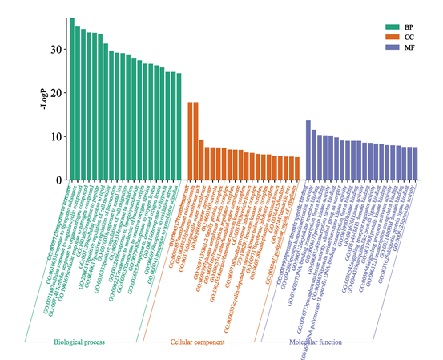 Figure 4: Functional enrichment analysis of intersection gene target GO.
Figure 4: Functional enrichment analysis of intersection gene target GO.
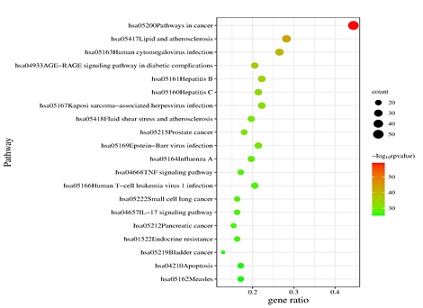 Figure 5: Enrichment Analysis of KEGG Pathway of Intersection Gene Target.
Figure 5: Enrichment Analysis of KEGG Pathway of Intersection Gene Target.
Discussion
IgAN is the most common primary glomerulopathy in the world. The incidence rate of IgAN among adults in the world is at least 2.5/100000 per year, and it is more common among Asian people. In China, IgAN accounts for 30-40% of primary glomerulopathy, and 20-40% of IgAN patients progress to end-stage renal disease (ESRD) within 10-20 years after diagnosis [6]. Numerous studies have pointed out that IgAN is caused by multiple factors such as genes, immunity, and environment, but the specific pathogenesis is still unclear. At present, the most basic treatment mode for IgAN in clinical practice is to prevent and treat infection, control blood pressure, administer sufficient levels of renin angiotensin aldosterone system(RAAS) blockers, control protein and salt intake, avoid fatigue and use nephrotoxic drugs, quit smoking, control metabolic syndrome, and regularly follow up. There is a lack of specific treatment methods. TCM has good therapeutic effects on IgAN. In the field of kidney disease, Erzhi Pill can be used for chronic nephritis, hematuria, lupus nephritis, purpura nephritis, chronic kidney failure and other diseases [7], with anti-inflammatory, antioxidant, immune regulatory and other pharmacological effects. Basic research [8] also suggests that Erzhi Pill extract can regulate the expression of podocyte membrane protein CD2AP and podpcin in rats with diabetes nephropathy, protect podocytes and then repair renal function.
This study found that the main effective components of Erzhi Pill in the treatment of IgAN were quercetin, luteolin, kaempferol, through the network diagram of Erzhi Pill active ingredient gene target β- Sitosterol, Robinia pseudoacacia. Quercetin, as a type of flavonoid, has various properties such as antioxidant, anticancer, anti-inflammatory, and neuroprotective properties. Quercetin can alleviate diabetes nephropathy by inhibiting oxidative stress and inflammatory pathways, promoting podocyte autophagy and inhibiting the overactivity of RAAS. In addition, quercetin can also regulate macrophages and inhibit mammals β- Chain protein signaling plays a protective role in the kidneys [9,10]. Luteolin can protect against renal ischemia and kidney damage caused by various nephrotoxic drugs through anti-inflammatory and antioxidant pathways [11]. Zhang et al., [12] found that luteolin can inhibit inflammatory reaction and oxidative stress by inhibiting the activation of STAT3, thereby reducing glomerulosclerosis and interstitial fibrosis in the model of diabetes nephropathy in mice. Research has shown that kaempferol can protect glomerular mesangial cells through antioxidant stress and inhibition of mitochondrial/cytochrome C mediated cell apoptosis pathways. It can also regulate M1/M2 polarization of glomerular macrophages and reduce TNF- α And IL-1 β Horizontal inhibition of podocyte apoptosis, while promoting the release of GLP-1 and insulin, inhibiting RhoA/Rho kinase and fibrosis, plays a role in alleviating glomerular matrix fibrosis [13]. β- Sitosterol can improve renal toxicity, renal cancer, and other kidney diseases through antioxidant, anti-inflammatory, and anti-apoptotic effects. Robinia pseudoacacia extract has antioxidant, anti-inflammatory, and antioxidant effects. It improves renal histopathological and functional indicators caused by ischemia-reperfusion in mice in a dose-dependent manner, and plays a protective role in the kidneys [14].
PPI analysis shows that the core targets of Erzhi Pill in treating IgAN are mainly AKT1, IL6, TNF, CASP3, VEGFA, etc. Research has shown that the absence of AKT1 can exacerbate azotemia and kidney damage such as tubular injury, renal fibrosis, and glomerulosclerosis by increasing renal tubular cell apoptosis and inflammatory response during renal ischemia-reperfusion. IL-6 and TNF, as inflammatory cytokines, can participate in the occurrence and development of IgAN by promoting mesangial cell proliferation, abnormal production of mesangial matrix, and inducing inflammatory responses in podocytes and renal tubular cells [15]. VEGFA, as a key mediator of angiogenesis, is mainly expressed and secreted in podocytes and renal tubular epithelial cells. Its abnormal expression can lead to many kidney diseases related to glomerular injury [16,17]. CASP3 is an important mediator of inflammatory cell apoptosis, and its lack of expression can lead to the deposition of immune complexes containing IgA and complement 3 in the cell matrix and mesangial regions, as well as podocyte damage and inflammatory cell infiltration in the renal tubulointerstitium, resulting in proliferative glomerulopathy in the kidneys [18].
According to GO enrichment analysis, Erzhi Pill mainly participates in biological processes such as response to oxidative stress, response to hypoxia, and response to reactive oxygen species. The enrichment analysis of KEGG pathway mainly focuses on cancer pathway, lipid and atherosclerosis signaling pathway, fluid shear stress and arteriosclerosis pathway, bladder cancer pathway, IL-17 signaling pathway, TNF signaling pathway, etc. Among them, IL-17 signaling pathway, TNF signaling pathway, as inflammation related pathways, has a significant correlation with the development and prognosis of IgAN. IL-17 is a pleiotropic cytokine that mediates tissue inflammation by inducing the expression of pro-inflammatory cytokines, chemokines, and MMPs [19]. Research has shown that serum IL-17 levels in IgAN patients increase, which may participate in the development of kidney disease by inducing the production and glycosylation of IgA1 in B cells, as well as stimulating the release of cytokines from peripheral blood monocytes in IgAN patients [20,21]. In addition, IL-17 can activate NF- κB and induce NF-κ The expression of B-dependent cytokines indirectly activates the NF kappa signaling pathway (classical pathway), which subsequently leads to inflammation, immunity, vascular wall response, and proliferation. TNF mainly regulates immune function by promoting immune cell activation and recruitment, and can trigger cell proliferation, differentiation, apoptosis, and necrotic apoptosis. In an inflammatory state, it can be excessively produced in podocytes, mesangial cells, proximal tubules, and glomerular cells, thereby promoting the development of renal fibrosis [22]. In addition, lipid and atherosclerotic signal pathways, fluid shear stress and arteriosclerosis pathways are closely related to blood lipids, arteriosclerosis, etc. Research indicates that they can affect the large, medium and small arteries of the kidney and cause renal damage such as glomerular arteriosclerosis.
In summary, the classic formula Erzhi Pill has a solid theoretical foundation in TCM and a large amount of clinical and experimental foundations. Based on the research foundation of network pharmacology, it can be confirmed that Erzhi Pill can act on IgAN through multiple pathways and targets. Erzhi Pill mainly treats IgAN through quercetin, luteolin, kaempferol β- Effective ingredients such as sitosterol and acacia act on gene targets such as AKT1, IL6, TNF, CASP3, and VEGFA, and play a role through lipid and atherosclerosis, fluid shear stress, atherosclerosis, IL-17, TNF, and other signal pathways, but further clinical intervention research is still needed. The results of this study reflect the synergistic molecular mechanism of Erzhi Pill in terms of multiple pathways and targets, providing research ideas and guidance for the clinical treatment of IgAN.
Funding Statement
Project supported by the Research Fund of Guangdong Provincial Bureau of Traditional Chinese Medicine (20231304).
Conflict of Interests
The author declares that the research was conducted in the absence of any commercial or financial relationships that could be construed as a potential conflict of interest.
References
- Zeng H, Wang L, Li J, Luo S, Han Q, et al. (2021) Single-cell RNA-sequencing reveals distinct immune cell subsets and signaling pathways in IgA nephropathy. Cell Biosci 11: 203.
- Ru J, Li P, Wang J, Zhou W, Li B, et al. (2014) TCMSP: a database of systems pharmacology for drug discovery from herbal medicines. J Cheminform 6: 13.
- The UniProt Consortium (2023) UniProt: the Universal Protein Knowledgebase in 2023. Nucleic Acids Res 51: 523-531.
- Stelzer G, Rosen N, Plaschkes I, Zimmerman S, Twik M, et al. (2016) The GeneCards Suite: From Gene Data Mining to Disease Genome Sequence Analyses. Current Protocols in Bioinformatics 54: 1-30.
- Zhou Y, Zhou B, Pache L, Chang M, Khodabakhshi AH, et al. (2019) Metascape provides a biologist-oriented resource for the analysis of systems-level datasets. Nat Commun 10: 1523.
- Li LS, Liu ZH (2004) Epidemiologic data of renal diseases from a single unit in China: analysis based on 13,519 renal biopsies. Kidney Int 66: 920-923.
- Floege J, Rauen T, Tang S (2021) Current treatment of IgA nephropathy. Semin Immunopathol 43: 717-728.
- Hosseini A, Razavi BM, Banach M, Hosseinzadeh H (2021) Quercetin and metabolic syndrome: A review. Phytother Res 35: 5352-5364.
- Deng X, Luo Y, Lu M, Guan T, Li Y, et al. (2022) Unraveling the Mechanism of Zhibaidihuang Decoction against IgA Nephropathy Using Network Pharmacology and Molecular Docking Analyses. Tohoku J Exp Med 259: 37-47.
- Lu H, Wu L, Liu L, Ruan Q, Zhang X, et al. (2018)Quercetin ameliorates kidney injury and fibrosis by modulating M1/M2 macrophage polarization. Biochem Pharmacol 154: 203-212.
- Diniz LRL, Elshabrawy HA, Souza MTS, Duarte ABS, Madhav N, et al. (2022) Renoprotective Effects of Luteolin: Therapeutic Potential for COVID-19-Associated Acute Kidney Injuries. Biomolecules 12: 1544.
- Zhang M, He L, Liu J, Zhou L (2021) Luteolin Attenuates Diabetic Nephropathy through Suppressing Inflammatory Response and Oxidative Stress by Inhibiting STAT3 Pathway. Exp Clin Endocrinol Diabetes 129: 729-739.
- Yang Y, Chen Z, Zhao X, Xie H, Du L, et al. (2022) Mechanisms of Kaempferol in the treatment of diabetes: A comprehensive and latest review. Front Endocrinol (Lausanne) 13: 990299.
- Shiravi A, Jalili C, Vaezi G, Ghanbari A, Alvani A, et al. (2020) Acacetin Attenuates Renal Damage-Induced by Ischemia-Reperfusion with Declining Apoptosis and Oxidative Stress in Mice. Int J Prev Med 11: 22.
- Schena FP, Rossini M, Abbrescia DI, Zaza G (2021) The molecular mechanisms of inflammation and scarring in the kidneys of immunoglobulin A nephropathy : Gene involvement in the mechanisms of inflammation and scarring in kidney biopsy of IgAN patients. Semin Immunopathol 43: 691-705.
- Ke B, Huang J, Duan Z, Shen W, Wu Y, et al. (2022) VEGFA promotes the occurrence of PLA2R-associated idiopathic membranous nephropathy by angiogenesis via the PI3K/AKT signalling pathway. BMC Nephrol 23: 313.
- Eremina V, Sood M, Haigh J, Nagy A, Lajoie G, et al. (2003) Glomerular-specific alterations of VEGF-A expression lead to distinct congenital and acquired renal diseases. J Clin Invest 111: 707-716.
- Suzuki T, Ichii O, Nakamura T, Horino T, Elewa YHA, et al. (2020) Immune-associated renal disease found in caspase 3-deficient mice. Cell Tissue Res 379: 323-335.
- Biswas PS (2018) IL-17 in Renal Immunity and Autoimmunity. J Immunol 201: 3153-3159.
- Lin JR, Wen J, Zhang H, Wang L, Gou FF, et al. (2018) Interleukin-17 promotes the production of underglycosylated IgA1 in DAKIKI cells. Ren Fail 40: 60-67.
- Matsumoto K, Kanmatsuse K (2003) Interleukin-17 stimulates the release of pro-inflammatory cytokines by blood monocytes in patients with IgA nephropathy. Scand J Urol Nephrol 37: 164-171.
- Lousa I, Reis F, Santos-Silva A, Belo L (2022) The Signaling Pathway of TNF Receptors: Linking Animal Models of Renal Disease to Human CKD. Int J Mol Sci 23: 3284.
Citation: Li X-X, Lai L-N, Zhang J-T, Ding X-Y, Yang L-F, et al. (2023) Exploring the Mechanism of Er-zhi wan for the Treatment of IgA Nephropathy Based on Network Pharmacology. J Altern Complement Integr Med 9: 420.
Copyright: © 2023 Xue-Xia Li, et al. This is an open-access article distributed under the terms of the Creative Commons Attribution License, which permits unrestricted use, distribution, and reproduction in any medium, provided the original author and source are credited.

